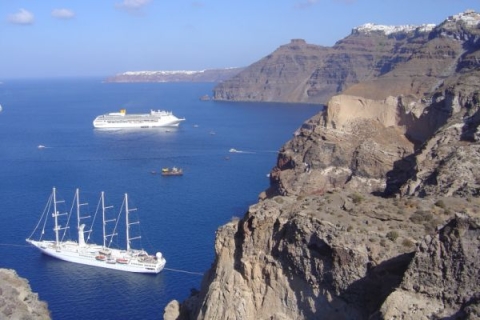

The rise and fall of sea level has, for the first time, been shown to influence the likelihood of volcanic eruptions
2 August 2021
7 min read
The rise and fall of sea level has, for the first time, been shown to influence the likelihood of volcanic eruptions.
Research on the Greek island of Santorini, co-authored by two Portsmouth scientists, analysed the timings of eruptions over hundreds of thousands of years in relation to past sea level changes.
The researchers found that a 40-metre fall in sea level is the critical point beyond which eruptions are more likely to occur.
The findings could have implications for millions of people living on volcanic islands around the world.
With continuing global warming, we need to urgently understand the relationships between the effects of climate change and the risk of natural hazard events.
Dr Mark Hardiman, Senior Lecturer at the School of the Environment Geography and Geosciences
One of the co-authors, Dr Mark Hardiman, at the University of Portsmouth, said: “With continuing global warming, we need to urgently understand the relationships between the effects of climate change and the risk of natural hazard events. One such hazard is volcanic eruptions on small islands and in coastal areas that are already strongly impacted by the consequences of rising sea level and increasing storm activity.”
The research published in Nature Geoscience was led by Dr Christopher Satow at Oxford Brookes and an international team of volcanologists and palaeoenvironmental researchers, including staff from the School of the Environment, Geography and Geosciences at the University of Portsmouth.
Dr Satow said there are clues about past volcanic activity on Santorini in the layers of volcanic rock on the cliff face encircling the inner part of the island: “A huge eruption 3,600 years ago caused the centre of what was then a conical island to sink into the sea, revealing an extraordinarily detailed history of over 200 previous volcanic eruptions preserved within the remaining circle of cliffs.”
Co-author Dr Sabine Wulf, also at the University of Portsmouth, had recently published a study analysing and dating volcanic rock layers on Santorini in great detail, and so provided the crucial record of past volcanic eruptions in Santorini needed for this new study.
Dr Wulf said: “Previous studies suggested that volcanic activity in commonly glaciated inland areas, such as in Iceland, is increased during warmer climate periods with higher sea level and decreased during ice ages which are characterised by significantly lower sea level. This relationship was also believed to apply to smaller island and coastal volcanoes. However, our new research at Santorini Island shows the opposite. It would appear rather drastic drops in sea level trigger major volcanic eruptions than increasing sea levels.”
It would appear rather drastic drops in sea level trigger major volcanic eruptions than increasing sea levels
Dr Sabine Wulf, Reader in Environmental Change at the School of the Environment Geography and Geosciences
Comparing the island’s eruption history to the sea level records allowed the team to show for the first time that the sea level has had an important role in determining the timing of eruptions at Santorini, and probably at many other island volcanoes around the world.
Dr Satow said: “The mechanism is quite simple: falling sea levels remove mass from the Earth’s crust and the crust fractures as a result. These fractures allow magma to rise and feed eruptions at the surface.”
The researchers say that eruptions at hundreds of other volcanic islands around the world may also have been influenced by fluctuations in sea level.
He added: “Just as when you pull a plug out of the bath, the water level drops everywhere throughout the bath at the same time; in a similar way, sea level changes occur at the same time everywhere across the globe.”
Large volcanic eruptions can change the climate, for example the eruption of the Philippines’ Mt. Pinatubo in 1992 resulted in a fall in global temperature of 0.5℃.
The mechanism is quite simple: falling sea levels remove mass from the Earth’s crust and the crust fractures as a result. These fractures allow magma to rise and feed eruptions at the surface
Dr Christopher Satow, Senior Lecturer in Physical Geography at Oxford Brookes University
Dr Satow said it was known climate change had an impact on volcanic activity, but what was less well known is that over long timescales, the climate can also affect volcanoes.
He said: “As ice sheets retreated across volcanic landscapes after the last ice age, the removal of ice mass changed the stress conditions in the Earth’s crust, allowing the fractures which feed volcanic eruptions to form more easily and therefore triggering activity.
“As these ice sheets melted the global sea level rose rapidly, by around 100 metres, adding a significant mass to the crust around many volcanic islands which, in theory, should alter their eruptive activity.
“Fifty-seven per cent of the world’s volcanoes are islands or are coastal, and are often home to large populations. Further vital research is needed to fully understand the effects of changing sea level on these volcanoes and the risks they pose to their populations.”
Dr Wulf said: “If our findings could be confirmed by studies on other volcanic locations around the world, continuing sea level rise would lower the risk of future volcanic eruptions at islands and coastal areas. This indeed would be good news not only for the population of Santorini, but also for other volcanic high-risk areas in the Mediterranean such as the densely populated Naples area in southern Italy.”
Eruptive Activity of Santorini Volcano Controlled by Sea Level Rise and Fall is published in Nature Geoscience. The research received funding from RCUK | Natural Environment Research Council (NERC) and Vetenskapsrådet (Swedish Research Council)
